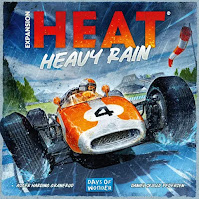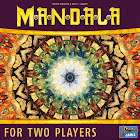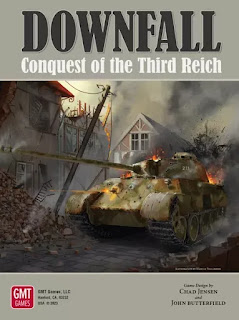Axis & Axis & Allies
Designers: Chad Jensen & John Butterfield
Player count: 2
Publisher: GMT Games
When
my friend Chad Jensen passed away, he left behind several designs he never had
time to complete. One of them was Downfall,
a two-player strategic-level wargame that models the collapse of the German war
machine in the last act of WWII. There was a lot of potential in that work-in-progress,
so veteran designer John Butterfield took up the torch and, with the help of
Chad’s widow Kai, completed the design for GMT Games to publish.
(No
small feat, considering no rulebook existed: John and Kai reconstructed the
game based on detailed prototype components and Kai’s memories of playing Downfall’s many incarnations with Chad.)
Now,
if you play any mid- to late-WWII east front game, you’re either at the wheel
of the Soviet juggernaut, or you’re handling a retreat of German forces—not the
most exciting of propositions. (Which is why east front games often focus on
the brutal stalemate of the front line, until it crumbles one way or another.
The drive back to Berlin by Soviet forces is like watching an hourglass inexorably
counting down time.)
And
if you play a similar game covering the western theater of operations, sooner
or later—after explosive situations like the Normandy landings—you’ll find
yourself either driving the Allied bulldozer, or handling a retreat of German
forces. Again, not the thrill of a lifetime for the German player.
What
the designers are proposing here is a framework where one player handles the
Allies and the Germans fighting the
Soviets, while the other player joins in as the Soviets and the Germans fighting the Allies.
While that basic conceit is not exactly new, the game’s many inspired design
decisions coalesce into an exciting tug of war between east and west, with a disintegrating
Third Reich caught in the middle.
 |
| And the campaign game is underway! |
Downfall’s main engine is the initiative
track that runs halfway around the huge game map, and which determines who
plays next. Each faction (Western, Soviet, and both German groups) is
represented there by an initiative marker, with whoever’s currently last on the
track getting a go. That faction selects an available order (more on that in a moment)
and pays the cost of said order—in initiative points—by moving their marker
forward along the track, to the tune of one space per point. Then it’s the turn
of the faction that’s now in last place on the initiative track, and so on.Available
orders fluctuate from turn to turn, as markers are drawn at random and laid out
on the action track. Whenever a faction picks a marker, they pay the associated
cost—which is not the same for all factions—execute the selected order, then
slide down the remaining orders (towards space #1) and draw a new order marker
at random to fill out the row. The cost of an order (in initiative points)
increases by 1 for each eligible marker the active faction skipped over,
starting with space #1; so if you really want that Reinforcement order now but it stands behind a handful of
other markers in your color, you better be prepared to pay for it—and
subsequently wait a while before that faction gets to play again.
All
of the order markers will show up on the action track before the end of the
game year, but in exactly what order remains to be seen. Maybe your orders to
embark for Calais or to march on Moscow will have to wait, and you will need to
do the best with what you have in the meantime.
And
this is one design quirk (of many!) that will delight some wargamers—myself included—while
irking others, depending on whether you think such a mechanic models the
vagaries of war or else just feels “too gamey” for something like a wargame.
Orders—once
you do get to play them—allow you to move units, conduct attacks on neighboring
hexes, bring much needed reinforcements into play, engage in strategic warfare,
and generally make life difficult for the other guy. (There’s a nasty little
order that, as the Germans, you can use to make the other Germans—the ones facing your main faction—waste precious
initiative points. Played at just the right time, that order tastes like
honey.)
I
want to point out that “moving a unit” is not dictated by an individual piece’s
movement allowance (as is traditionally done) but rather by the order marker
itself. For instance, one of them will allow Western units to each spend 4
movement points, whether they be mighty armored units glinting in the North
African sun, or mud-stained grunts suffering the elements in the Caucasus.
Combat
is resolved using a table that compiles step advantage (I’m attacking with 7
steps worth of units while you defend with 4 steps, so I’ll roll on the +3
column), and die-roll modifier advantage (my planes and a card I played grant
me a +5, but the weather and your fortress throw a -4 into the mix, and so I’ll
end up adding 1 to my roll), with results expressed in hits that must be
distributed amongst attacking and defending units.
Those
hits are absorbed by rotating a unit so that its top edge displays fewer steps
(pips), and in some instances by retreating one or more hexes away from the location
where combat took place. You can also decide (or be forced!) to flip one of
your armored units back to infantry, which has left more than a few scars on my
already troubled soul.
The
progression of weather (and, ultimately, game years) works in a fashion similar
to initiative markers, with a dice roll moving the weather marker along the
initiative track each time a faction begins their turn with the weather marker
behind of flush with them. (The 2d6 roll is capped at wherever the leading
marker stands on the initiative track, so true runaway weather cannot take
place; although beware of sudden bursts, for they do happen.) When the weather
marker crosses into a new “weather zone” on the initiative track, fair can turn
to mud or mud to snow, which creates logistical problems in strategic
locations.
Once
the weather marker reaches the end of the track and loops back to the start, a
new game turn begins! All used order markers are returned to the mix, new cards
are added to their respective decks, possible reinforcements make an appearance
and, naturally, the weather wheel gets another crank.
Event
cards throw in some uncertainty that will affect the ebb and flow of the entire
campaign. Events are present in three places: face up on top of the draw pile
(the upcoming event, not yet active), face up as the current event, and face up
on top of the discard pile—each showing an actual event, along with variable
numbers of card, airplane and die icons. Together, these three face-up event
cards determine how many aircraft each faction can deploy to the map (hoping
their range will be sufficient to positively affect critical battles) as well
as bonus dice-roll modifiers and the influx of action cards.
For
their part, action cards allow factions to surprise their opponents with extra
steps or modifiers in combat, plus a host of assorted effects that move units
in special ways, provide free combat opportunities, cancel a card play (or a
dice roll!), allocate reinforcements, launch paratroopers…
The
main goal of the game is to score victory points, normally accomplished through
the capture of strategic objectives on the map. At game end, after a set number
of turns, whoever has the most points wins—Western or Soviet. (Germany cannot
win.) It can’t hurt to take Berlin, mind you, since that achievement, worth 1
VP, also doubles as the first tiebreaker. (The second tiebreaker grants victory
to the player who holds the most action cards; and yes, one of my games ended
with my being the lucky beneficiary of this rule, which my partner and I
learned together while digging through the rulebook, looking for salvation.)
WAR
PRODUCTION
Downfall comes in a slim and sturdy box
that’s deep enough to accommodate a counter tray and all of the game’s 110
cards in sleeves. That’s with the two paper maps that make up the game board,
and which you’ll be fine with if you have enough yardage of Plexiglass at your
disposal, or if you resort to sticking the two halves together. (Post-Its on
the back side can work surprisingly well.)
Should
you be so inclined, you can purchase a pair of mounted maps that come with
their own 3-inch box. They’ll take some time to lie flat, but once they do,
you’ll be cooking with gas.
The
rest of the equipment is pretty straightforward: a myriad of counters (with
beautiful rounded corners), useful player aid cards, handy setup cards, a rulebook
and a handful of six-siders.
It’s
all the game needs to blow you away.
RULES
OF ENGAGEMENT
The
rulebook clocks in at 40 pages, with plenty of illustrated examples throughout.
It’s a pleasant document to read and acts as an effective learning tool—even
away from the map—but stumbles a bit when it comes to looking up specific
topics in the heat of battle. Some pieces of information are not found where
you think they should be (such as the initiative cost for the Re-seed order)
but it mostly comes down to a fledgling index that’s missing some key terms like “reinforcements.”
Nevertheless,
it’s a very good rulebook you’ll rapidly find yourself using less and less,
thanks to rules that have been streamlined like a bullet train. The game
presents very few special cases, shifting to a different system instead of
trying to stick round exceptions into square holes. It simplifies all it can
without losing its grip on the essence of each situation, like the way terrain
costs are handled: moving into clear terrain costs 1 movement point, while
everything else costs 2, for all units. Sure, weather will play havoc with
swamps and mountains, and you’ll bless rail lines when you can use them, but
you’ll take one look at the terrain chart and be done with it.
Naval
and aerial rules have also been boiled down to essentials, which doesn’t mean
they have a marginal impact on the business at hand. On the contrary, they
influence everything under the sun, and in different ways as the game soldiers
forward (as they should). But those rules don’t get bogged down in minutiae and
as a result fade into the background after a few turns.
For
all those details you fear you might forget (What happens exactly when a new
turn begins? How does mud weather meddle with combat again?), the game’s
various player aid materials have your back. I hardly ever look at the rulebook
anymore, except perhaps to look up an obscure tie breaker when the game is
insanely tight.
FUN
FACTOR
The
only point that makes people shriek when I tell them about Downfall is the length of the game. Fair enough: 12 hours for the
campaign game is a far cry from the two-hour Combat Commander sessions most Jensen fans will be accustomed to.
(Hell, even the “short” game in Downfall,
the Overlord scenario, will require at least six hours of your time.)
But
the key thing here is not to confuse long
with slow.
No
matter which of the three scenarios you decide to tackle, you’ll never
experience downtime. At all. Even when your “main” faction has relatively few
things to do—like the Western faction at the start of the campaign game—you’ll
still have your hands full trying to contain the opponent’s attack using your
allotment of German forces. You’ll keep an eye on the cycling events that’ll
impact many of your endeavors, trying to put in place the conditions that will
trigger the replacement of card A with card B in the stack (the surrender of
Italy, for instance) and keep History moving forward. You’ll track your
opponent’s expenditure of initiative points, because that’ll determine when’s
the next time they get to act. And you’ll watch that weather forecast like a
hawk, lest unforeseen snow derail the crucial counterattack you spent your last
few moves setting into motion.
My
most recent game, an Overlord confrontation, lasted seven hours (which,
considering my opponent had never played the game before, was surprisingly
fast). When all was said and done, we both felt like we’d been sitting at the
gaming table for two and a half hours—three on the outside. The game is that
fascinating. And if Life hadn’t decided that we had other matters to attend to,
we might have set up the damn thing anew and started again right there and
then.
PARTING
SHOTS
As
much as there is to love in Downfall,
my biggest infatuation lies in the uncertainty that permeates most systems. The
game goes beyond dice-based combat resolution (a wargame staple) to ensure that
while you may elaborate meticulous plans, you can’t know for
certain how or when things will start to unfold.
I’ve
already talked about order counters, and how all orders for each faction will
eventually land on the action track but still keep details that pertain to
timing and quantities shrouded in relative mystery. Likewise, weather likes to
keep to itself: you know what the weather will turn to when it does change, but
can’t be sure of when that will be. (Educated guesses are your best friends
here.)
Reinforcements
are not handed down with each new game year: they move into a holding pattern
from which only one event—High Command—will free them. But when, exactly, will
that event pop up? You’ll see it one turn early (when it’s revealed, face up,
on top of the event draw pile), but that’s all the advance warning you’ll get.
The
same can be said of every single event in the game, or indeed of the event
trigger itself, which comes into play when a faction’s initiative counter
reaches its own event space on the initiative track. So while you exert some
measure of control over the timing of events, the balance is left in the hands
of your opponent. Also, all events come from a single deck, which makes it difficult to know whether the event you're about to reveal will help you or not. (But remember, you have until the next event trigger until this newly revealed event becomes active.)
Still, is the game length a deterrent? It could be, but not if you can spare a long
day to get through a scenario, or if you have access to an out-of-the-way table
where the game can idle like the engine of a T-34 running low on diesel, between
sessions sprinkled over a couple of weeks.
I myself
am not a fan of long-winded, overly heavy wargames. I often see guys playing one such
game at some convention, where they spend the morning setting everything up
and, upon being asked where things stand at the end of Day 1, reply something
along the lines of “Oh, we’re just getting started, you know, our units haven’t
met on the battlefield yet.” Rest assured this is definitely not the way Downfall unspools. Every scenario—yes,
even the campaign one—launches both players right into the action and never
slows down. Remember that Overlord game I mentioned above? The conclusion to
our game day (at the tail end of a seven-hour stretch) was so electrifying that
we played our last few turns standing up.
Everything
in the game moves like a well oiled clock, with systems engaging each other the
way precision-made cogs mesh together. The game flow is so engrossing that at
some point I mentally took a step back just to watch the machine in action, and
I couldn’t help but break into a smile.
In point
of fact, I’m still smiling.
# #
#






























